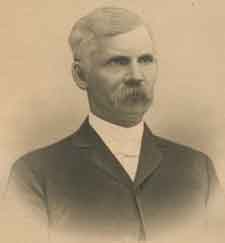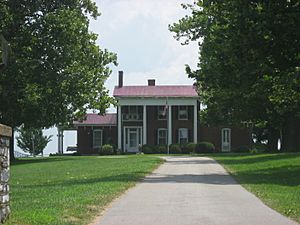Bennett H. Young facts for kids
Quick facts for kids
Bennett H. Young
|
|
|---|---|
 |
|
| Born | May 25, 1843 Nicholasville, Kentucky, U.S.
|
| Died | February 23, 1919 (Aged 75) |
| Military career | |
| Allegiance | |
| Service/ |
Confederate States Army |
| Years of service | 1861–1865 |
Bennett Henderson Young (born May 25, 1843 – died February 23, 1919) was a soldier for the Confederate States Army during the American Civil War. He is best known for leading a military action called the St Albans raid on October 19, 1864. During this event, he entered Vermont from Canada and took control of the town of St. Albans.
Contents
Bennett Young's Early Life
Bennett Young was born in Nicholasville, Kentucky, on May 25, 1843. His parents were Robert Young and Josephine Henderson. When he was 17 years old, he joined the Confederate 8th Kentucky Cavalry. This unit was part of General John Hunt Morgan's cavalry group.
The St. Albans Raid Explained
Young was captured during John Hunt Morgan's 1863 raid in Ohio. However, he managed to escape to Canada later that year. From Canada, Young traveled south through Nova Scotia and Bermuda. There, he suggested a plan for raids from Canada into the Union states. His idea was to gather money for the Confederate government. He also hoped to make the Union army send troops to protect their northern border. This would distract them from other areas.
Young was made a lieutenant and went back to Canada. He found other escaped Confederate soldiers to join him. On October 19, 1864, they carried out a raid on St. Albans, Vermont. This was a quiet town about 15 miles (25 km) from the Canada–US border.
Planning the St. Albans Raid
On October 10, Young and two others checked into a local hotel in St. Albans. They told people they were from St. John's, Canada, on a "sporting vacation." Each day, two or three more young men arrived. By October 19, there were 21 cavalrymen ready.
The Raid on St. Albans
Just before 3:00 p.m., the group attacked the three banks in St. Albans at the same time. They announced they were Confederate soldiers and took about $208,000. While the banks were being robbed, eight or nine Confederates held townspeople captive on the village green. They also stole horses. Sadly, one townsperson was killed and another was hurt. Young ordered his troops to burn the town. However, the special bottles of Greek fire they brought did not work well. Only one shed was destroyed.
After the Raid: Escape to Canada
The raiders quickly fled with the money back into Canada. Canadian authorities arrested them and held them in Montreal. The Lincoln administration in the U.S. wanted the raiders sent back to America. They hired a well-known lawyer, Bernard Devlin, to help with the case.
The Canadian court decided that the soldiers were acting under military orders. Canada was officially neutral in the war. Because of this, they could not send the soldiers back to America. The raiders were set free. However, the $88,000 they still had was returned to Vermont.
Bennett Young's Life After the War
After the Civil War ended, Bennett Young was not allowed to return home right away. This was because of a special order from President Andrew Johnson. So, he spent time studying law and literature in Ireland at the Queen's University of Ireland. He also studied at the University of Edinburgh in Scotland.
He was finally allowed to return to the United States in 1868. He became a very important lawyer in Louisville, Kentucky. Young was known for his generous work helping others. He started the first orphanage for Black children in Louisville. He also helped create a school for the blind. He often worked for free to help poor people.
Young also worked as a railroad officer. He was the President of the Louisville Southern Railroad. He also wrote several books. Young was on the board of trustees for the Confederate Veteran magazine.
Public Service and Community Work
In 1876, the Governor of Kentucky chose Young to represent the state at the Paris Exposition. This was a big international exhibition.
In 1878, Young joined the Polytechnic Society of Kentucky. He helped the organization with its finances. Later, he became the president of the society.
In 1899, Young helped a former slave named George Dinning in a court case against the Ku Klux Klan.
Between 1890 and 1908, Young played a key role in creating the Louisville Free Public Library.
In 1913, Young was chosen as the Commander-in-Chief of the United Confederate Veterans. He held this position until he retired in 1916. After retiring, he was named "honorary commander-in-chief for life."
Bennett Young's Family Life
In 1866, Bennett Young married Mattie R. Robinson. They had a son named Lawrence, who later became a lawyer in Chicago. In 1895, Young married again to Eliza S. Sharp. They had a daughter named Eliza Bennett Young.
Books Written by Bennett Young
- The Prehistoric Men of Kentucky
- The History of the Kentucky Constitution
- Evangelistic Work in Kentucky
- Battle of Blue Licks
- The History of Jessamine County
- The History of the Division of the Presbyterian Church in Kentucky
- The Battle of the Thames
- Kentucky Eloquence
Death and Lasting Impact
By 1908, Bennett Young was known as "the father of the Louisville Free Public Library."
He passed away on February 23, 1919, at his home in Louisville, Kentucky.
A railroad bridge over the Kentucky River at Tyrone, Kentucky, was named Young's High Bridge in his honor. The town of Youngstown, Kentucky, was also named after him.



